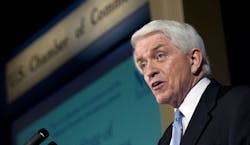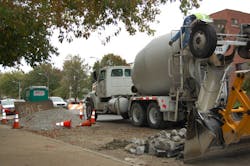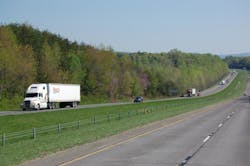Today is the day when Donald J. Trump becomes the 45th U.S. president (as improbable as that still sounds) and among the MANY questions I am sure motor carrier executives possess regarding this singular moment in our nation’s history is how his administration will impact the trucking industry.
For starters, from a broad perspective and at least initially, there’s a rising tide of optimism within the U.S. business community as a whole in terms of economic growth – and that would seem to bode well for freight demand.
For example, insurance provider New York Life recently surveyed more than 1,200 small business owners (with the help of Ipsos Public Affairs) and found that their financial expectations and “optimism” for 2017 outpaced that of the general public, by some 60% to 43% of Americans age 30 and over.
That “optimism” can be attributed to a number of areas, noted Brian Madgett, vice president of New York Life, in a statement:
- Technology – 75%
- The new political landscape – 57%
- The employment market/talent pool – 56%
- Interest rates – 54%
- Health insurance – 53%
“Small business owners are heading into 2017 with good feelings, and this was consistent across size and years in business,” Madgett added.
Thomas J. Donohue, president and CEO of the U.S. Chamber of Commerce, expressed a similar level of “optimism” on behalf of the U.S. business community as a whole during his annual State of American Business presentation last week.
“Business is optimistic because we see a once-in-a-generation opportunity to enact major reforms that could transform the American economy from a low-growth to a high-growth economy,” Donohue said in his remarks.
“We’re optimistic because even in the eighth year of an aging recovery there are no visible signs of another recession. We expect the economy to continue to grow modestly in 2017,” he added. “We’re optimistic because the housing market is healthy, energy prices have stabilized, inflation is under control, stock markets are performing well, and consumer and business confidence have improved.”
Two policy areas Donohue said the Chamber plans to focus on going forward in in line with its “optimistic” view will have big implications for trucking: regulatory rollback and infrastructure investment.
“To start, we need regulatory relief and regulatory reform. There is no justification for the regulatory overkill we have seen over the last eight years,” he said.
“An unelected fourth branch of government—the regulatory branch—is holding our small business sector back while imposing unnecessary costs on larger companies, too,” Donohue pointed out. “No one has been hurt more by this overkill than America’s small businesses. Small companies account for much of the innovation and more than 60% of the new job creation in our country.
He believes President Trump can begin to eliminate the “regulatory burdens” imposed by executive orders, while Congress can also move quickly on some of the recently imposed regulations by using the Congressional Review Act to scuttle them.
Donohue also pointed to infrastructure investments as a way to not only foster economic growth but improve U.S. “competitiveness” on the global market.“We should seize the opportunity created by the bipartisan support for infrastructure, but it would be a mistake to simply do more of the same old thing,” he noted.
“The projects we invest in must be determined by our national economic need for growth—not parochial politics,” he explained. “That means taking on large-scale projects—airports, seaports, pipelines, an expanded power grid, broadband, air traffic control, secure and efficient borders, and intermodal transportation links—projects that help the entire country.”
A policy initiative of that scale, obviously, would provide benefits to trucking along many fronts – work for construction fleets that will be tasked to help build it all, freight demand in the form of construction materials that need to be shipped hither and yon, plus “throughput” efficiencies as traffic bottlenecks are eased within the transportation system.
All of that will help lay the groundwork for what Donohue dubbed “long-term economic growth” for the nation, but he cautioned that it will neither be easy nor risk free.
“Good intentions are fine, but policymakers still must deliver the goods. That could take some time. Bills must be passed and then they have to take effect—all before the economic benefits can be realized,” Donohue emphasized. “Uncertainty is always a factor in business. And there is plenty of uncertainty today—not just at home but abroad.”For example, the Chamber is forecasting modestly improved gross domestic (GDP) growth for the U.S. in the range of 2% to 2.5% for 2017, with inflation expected to remain “subdued,” perhaps just above the Federal Reserve’s target of 2%.
As a result the Chamber expects two or even three additional interest rate hikes from the Federal Reserve over the course of the year, which could put U.S. monetary policy at odds with some of its trading partners—meaning the U.S. dollar is likely to be under significant upward pressure.
“A stronger dollar will benefit America’s consumers and importers and it may attract more capital here, but it will also make competing in global markets more difficult for our exporters,” Donohue noted.
That concern is shared by Wolters Kluwer Legal & Regulatory U.S., which noted its Blue Chip Economic Indicators panel of 53 economists also expects higher interest rates due to a further tightening of labor market conditions and higher overall inflation.
“The consensus still predicts U.S. real GDP will grow 2.3% in 2017 on a fourth quarter-over-fourth quarter basis,” noted Randell E. Moore, executive editor of Wolters Kluwer’s Blue Chip Economic Indicators. “This is 0.3% than the presumed increase in 2016.”
Other consensus findings from panel include:
- Almost 56% predict two 25-basis-point rate hikes from the Fed this year and close to 29 percent foresee three 25-basis-point rate hikes during the year.
- Minimal change since December’s survey in the consensus outlook for the U.S. economy’s performance in 2017;
- Increased protectionism and potential for a trade war is the biggest threat to improved U.S. economic growth in 2017, and the second highest-ranked threat is an additional increase in the foreign exchange value of the U.S. dollar.
“That’s why it is important that the new administration does not add to the burdens facing our exporters—or to the millions of American workers whose jobs depend on exports—by erecting barriers to trade,” the Chamber’s Donohue stressed in his remarks.
“Nonetheless, it’s very clear what our nation’s top priority must be: to restore our country to vigorous economic growth in order to expand jobs, incomes, and opportunities for all Americans,” he added.“As a new government comes to town, the Chamber’s overriding focus will be on those policies and reforms that can return robust growth to the American economy,” Donohue said. “We will judge every proposal on that basis, and we urge all policymakers to do the same. Ask a simple question: Will it speed [economic] growth or will it impede growth?
And more growth is key, as the Chamber’s forecast of 2% to 2.5% GDP growth “is nothing to celebrate,” he emphasized.
“It’s not enough to re-employ the millions of Americans who are out of work. It’s not enough to bring millions of Americans who have left the workforce back in—or to provide younger Americans with rewarding careers in their chosen fields,” Donohue noted. “It’s not enough to fuel resurgence in small business start-ups, which have fallen to a disturbingly low level. And it’s not enough growth to support the needs of an aging society—or to make even a dent in the funding shortfalls of our entitlement programs, or to slow the growth of the national debt.”
But even what many might think is a little extra growth can generate a lot of benefits.
“Numbers can be deceiving,” Donohue stressed. “If we are able to move our economy from 2% growth to 3% growth, that’s not a 1% increase in our performance—it’s a 50% increase. Yet ultimately, growth is not about numbers. Growth is about people. Increasing our growth rate 50% or more would have an extraordinarily positive impact on jobs, incomes, and opportunities—not just for the few, but for the many.”
And boost freight demand, too – don’t forget that. For if that happens, rates should rise and trucking should enjoy better days indeed.







